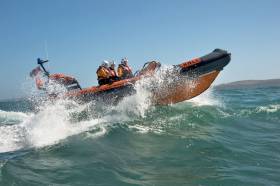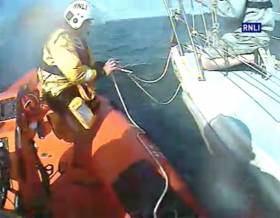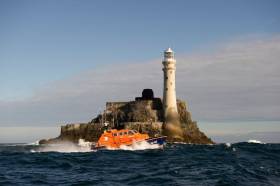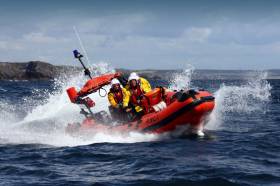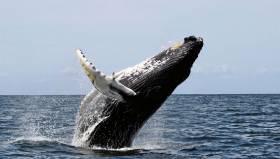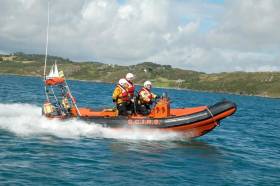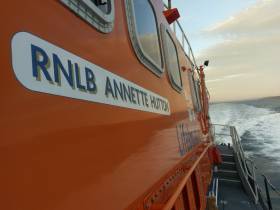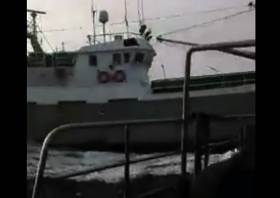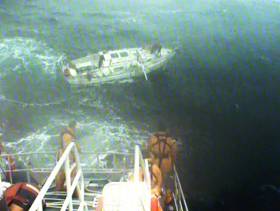Displaying items by tag: west cork
#RNLI - Baltimore RNLI assisted two sailors yesterday afternoon (Friday 14 July) after their motorboat broke down off the coast of West Cork.
The volunteer crew was requested to launch their inshore lifeboat at 2.25pm following a report from the sailors that their vessel had got into difficulty off Toe Head.
Helmed by Youen Jacob and with crew members Pat O’Mahony and Colin Rochford on board, the lifeboat launched immediately and was on scene in 25 minutes.
The 22ft motorboat had broken down half a mile west of Toe Head and had secured an anchor. Weather conditions at the time were relatively good, with a Force 3-4 south-westerly wind and a sea swell of 2-3m.
The lifeboat crew established a tow and brought the vessel safely back to Baltimore Harbour before returning to the station at 4.35pm.
“The sailors did the right thing today requesting assistance when required,” said Baltimore RNLI lifeboat operations manager Tom Bushe. “We would remind everyone enjoying our coast this summer to always respect the water.”
Shore crew in attendance at the station were Rianne and Jerry Smith, Kate Callanan, Marty O’Driscoll and Aidan Bushe.
#RNLI - Union Hall RNLI went to the aid of a yacht with two people onboard yesterday evening (Thursday 13 July) after the vessel got into difficulty half a mile east of Castlehaven Harbour in West Cork.
The volunteer lifeboat crew was alerted at 5.26pm by Valentia Coast Guard to reports of a 28ft yacht that had fouled its propeller.
The lifeboat was launched and on scene within 20 minutes. Weather conditions at the time were good and the sea was calm.
Two whale watching boats, Voyager and Liscannor Star, stood by the casualty vessel until the lifeboat crew arrived and worked with the two men onboard to attach a tow line to the yacht.
The lifeboat then towed the yacht to the safety of Reen Pier before returning to Union Hall, joined by a pod of dolphins along the way.
Speaking following the callout, Union Hall RNLI deputy launching authority Peter Deasy said: “We were happy to assist the sailors this evening on what was the first callout for our only female crew member, Sarah Browne.”
#RNLI - Baltimore RNLI’s volunteer lifeboat crew has responded to three callouts over the last four days.
The first of the three was a medical evacuation from Cape Clear on Friday (7 July).
A woman from the island was suffering from chest pains and needed to be transferred to the mainland, where she was met by a waiting ambulance at the lifeboat station.
The lifeboat was crewed by Kieran Cotter, Sean McCarthy, Cathal Cottrell, Aidan Bushe and Don O’Donovan.
The following night (Saturday 8 July), the lifeboat carried out another medevac, this time from Sherkin Island after man suffered a serious fall from a height and required medical assistance.
The lifeboat crew were assisted on the island by a team led by Dr Jason from West Cork Rapid Response.
The casualty was evacuated to Baltimore, where an ambulance was waiting at the lifeboat station for transfer to hospital in Cork.
Crew on this callout were Kieran Cotter, Pat Collins, Jerry Smith, Don O’Donovan, Brian McSweeney, Jim Griffiths and Ronnie Carthy.
Finally, yesterday morning (Sunday 9 July) Baltimore RNLI’s inshore lifeboat was launched to go to the assistance of a RIB which had broken down off Cape Clear.
Mícheál Cottrell, a helm and crewman with Baltimore RNLI, was out with his sea safari boat on a tour with passengers when he happened upon the boat, with two people onboard, which was suffering engine problems.
Cottrell raised the alarm and Baltimore’s inshore lifeboat was requested to assist.
The lifeboat took the boat in tow to Baltimore, where it was berthed safely and the lifeboat returned to station.
Crew on the inshore lifeboat were helm Youen Jacob, David Ryan and Ryan O’Mahony.
Shore crew in assistance at Baltimore Lifeboat Station were Declan Tiernan, Sean McCarthy, Rianne Smith and Marty O’Driscoll.
Union Hall Lifeboat Starts Summer Season With Two Callouts
#RNLI - It’s shaping up to be the start of a busy season for the volunteer lifeboat crew at Union Hall RNLI with two callouts in less than two weeks.
On Saturday 8 April, the inshore lifeboat launched at 12.14pm to Rabbit Island with reports of two sheep spotted on a low-lying cliff at the side of the island.
The crew went to the island to access the situation, and to eliminate the risk of members of the public trying to assist the sheep.
The volunteers went ashore and helped the sheep back onto the island, left them grazing and returned to Union Hall pier.
More recently, on Monday 17 April, Union Hall RNLI was requested by Valentia Coast Guard at 9.26pm to reports of two red flares spotted near Adam Island at the mouth of Glandore Harbour.
Launching five minutes later, the lifeboat crew proceeded to the scene and were joined by the Irish Coast Guard helicopter Rescue 117 from Waterford and Toe Head/Glandore Coast Guard Unit, who also had their shore crew assist.
A thorough search was conducted of the inner harbour and islands at the mouth of Glandore Harbour. Nothing was found and Union Hall RNLI was stood down at 10.53pm.
Speaking following the callouts, Pamela Deasy, Union Hall RNLI volunteer lifeboat press officer said: “As we approach the summer season we would remind everyone to respect the water and remember if you see anything suspicious or someone in trouble over the coming months, call 112/999 and ask for the coastguard.”
First Humpback Whale Of New 2017 Season Sighted Off West Cork
#MarineWildlife - The first humpback whale sighting for the new season in Irish waters was made last week off the Beara Peninsula.
The Irish Whale and Dolphin Group’s (IWDG) Patrick Lyne was in prime position to witness the unmistakable tail fluke some 5km offshore from Beara in West Cork on the afternoon of Wednesday 5 April.
While not the first humpback sighted this calendar year — that honour goes to a giant spotted off Wexford in early January — it’s still considered the first of the 2017/18 ‘large whale season’.
The sighting also continues a trend of earlier arrivals for Ireland’s regular humpback visitors over recent years, with 2016’s first recorded only four days later and spotted just 4km away.
Last Wednesday was a bumper day for marine wildlife sightings off Co Kerry, too, where Nick Massett spotted at least a dozen minke whales between Ventry, Slea Head and the Blaskets.
Many of these locations feature in Colin Stafford-Johnson’s new BBC TV series Wild Ireland, as BBC News reports. The two episodes are currently streaming via the BBC iPlayer, where available.
In other cetacean news, researchers believe that whale strandings may in part be caused by exhaustion when cetaceans flee human-made noise in the ocean.
According to the Irish Independent, a study by marine scientists at UC Santa Cruz found that beaked whales startled by low-frequency sonar raise their energy consumption by almost a third, increasing demands on their limited oxygen supply while below the surface.
The news will be fuel to those who suspect human activity at sea plays a major role in increased cetacean stranding rates.
As previously reported on Afloat.ie, 2017 became the worst year on record for whale and dolphin strandings by mid February.
Schull’s Community Lifeboat To Join Irish Coast Guard
#Rescue - Schull’s independent community lifeboat will soon join the Irish Coast Guard, as the Southern Star reports.
Established in 2005, the Schull Community Inshore Rescue Service will be officially renamed as Schull Coast Guard later this month after two years of talks on assimilating the West Cork volunteer rescue service with the national SAR agency.
A reception is planned to mark the change, details of which will be announced on the SCIRS Facebook page.
The Southern Star has more on the story HERE.
Dog Rescued From Coastal Cliff Face In West Cork
#Coastguard - Goleen Coast Guard raced to the rescue of a dog trapped on a coastal cliff face in West Cork yesterday morning (Wednesday 22 February).
As BreakingNews.ie reports, two coastguard climbers set up a rig to abseil down to the border collie, named Boo, who had slipped down the cliff at Castlepoint near Schull.
“All went according too plan and boo was safely brought back to her owners again,” said a Goleen Coast Guard spokesperson.
Early Hours Call For Castletownbere Lifeboat To Tow Vessel In Difficulty
#RNLI - Castletownbere RNLI was requested to go to the aid of a 36m vessel with mechanical difficulties north of the Bull Rock off the coast of West Cork on Friday evening (16 December).
The lifeboat, under the command of deputy coxswain Sean Bawn O’Sullivan, was launched within minutes and located the vessel at anchor about one hour later.
The vessel, the Ocean Guardian, was on passage from Castletownbere to Burtonport when it contacted Valentia Coast Guard.
With light winds and a 3-4m swell, RNLI volunteers passed a tow rope to the crew onboard, and the lifeboat took the vessel under tow to Castletownbere.
When off Crow Head some time later, the tow rope broke and had to be reattached. The tow was then completed without further difficulty.
The vessel was berthed alongside the pier in Castletownbere at 2.30am yesterday morning (Saturday 17 December).
West Cork Potter Has Close Call With Spanish Trawler
#Fishing - A small fishing vessel had a close call in West Cork this week when a much larger trawler powered past from Castletownbere with barely any room to spare.
According to the Irish Examiner, the crew of the Celtic Dawn were hailing pots offshore when the Spanish boat approached at speed, and appeared to be taking no evasive action.
Maritime law dictates that vessels such as the Celtic Dawn that are hauling static gear have the right of way, as The Irish Times reports.
And the captain of the smaller boat was not pleased about the situation.
“If it had been foggy, we would have been in trouble,” said Kieran Sullivan.
See video of the near collision below:
#RNLI - The Castletownbere lifeboat Annette Hutton was launched early yesterday morning (Saturday 20 August) when Valentia Coast Guard Radio requested assistance to a yacht in difficulties 45 miles south of Mizen Head in West Cork.
The 8m yacht with one person on board had left the Azores in early August and ran into difficulties in yesterday's severe weather.
The sailor, in his 60s, had been in regular radio contact with Valentia Coast Guard radio until yesterday morning, when his VHF radio was washed overboard. He activated an EPIRB to identify his location, raise the alarm and seek help.
The lifeboat, under the command of coxswain Brian O’Driscoll, was launched at 8am and located the casualty at 10.40am, some 50 miles south-west of Castletownbere. An Irish Coast Guard rescue helicopter was also on scene. Conditions were described as gusting Force 8/9 winds with a 30ft swell.
Amid the challenging sea conditions, the yacht was taken under tow and the lifeboat proceeded slowly to Castletownbere. Early into the tow, the lifeboat crew became concerned about the wellbeing of the sailor and the crew managed to transfer him to the lifeboat.
With the damaged yacht in tow, the lifeboat returned to Castletownbere at 8.30pm, having been at sea for 12-and-a-half hours.
Last night the sailor thanked the Castletownbere lifeboat and all involved for "saving his life", saying: "Only for the lifeboat, things would have ended up very badly today."
Commenting on the callout, Castletownbere RNLI lifeboat operations manager Tony O’Sullivan added: "The coxswain and crew are to be complimented on today’s rescue – they demonstrated skill, seamanship and endurance during what was a long and challenging day."



























